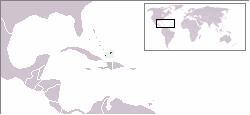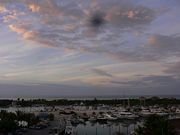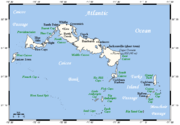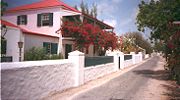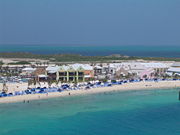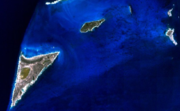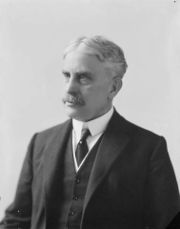Turks and Caicos Islands
2008/9 Schools Wikipedia Selection. Related subjects: Americas; Countries
| Turks and Caicos Islands | ||||||
|---|---|---|---|---|---|---|
|
||||||
| Anthem: " God Save the Queen" |
||||||
|
|
||||||
| Capital | Cockburn Town | |||||
| Largest city | Providenciales | |||||
| Official languages | English | |||||
| Government | British Overseas Territory | |||||
| - | Queen | Elizabeth II of the United Kingdom | ||||
| - | Governor | Richard Tauwhare | ||||
| - | Premier | Michael Misick | ||||
| Area | ||||||
| - | Total | 417 km² ( 199th) 161 sq mi |
||||
| - | Water (%) | negligible | ||||
| Population | ||||||
| - | 2008 estimate | 30,600 ( 208th) | ||||
| - | Density | 52/km² ( n/a) 135/sq mi |
||||
| HDI (n/a) | n/a (n/a) ( n/a) | |||||
| Currency | U.S. dollar ( USD) |
|||||
| Time zone | UTC-5 | |||||
| Internet TLD | .tc | |||||
| Calling code | +1 649 | |||||
The Turks and Caicos Islands (TCI) (pronounced /ˈtɜːks ænd ˈkeɪkəs/) are a British Overseas Territory consisting of two groups of tropical islands in the West Indies at .
History
The islands of the Turks and Caicos were first populated by Carib Amerindians.
Though many nations controlled the islands, official settlement did not occur right away. For several decades around the turn of the 18th century they became popular pirate hideouts. Bermudian salt collectors were the first to settle the Turk Islands in 1678 or 1681. In 1765–1783 they were under French occupation. After the American Revolution (1775–1783) many loyalists fled to British Caribbean colonies, including (in 1783) the first settlers on the Caicos Islands; cotton became an important crop briefly. In 1799 both island groups were annexed by Britain as part of the Bahamas.
There was a great deal of political turmoil surrounding the ownership of the Turks and Caicos even within the British empire: Bermuda had been in effective possession of them for a century, though, under British law they were the common wealth of all British citizens. Spanish and French forces seized the Turks in 1706, but Bermudian forces expelled them four years later in what was probably Bermuda's only independent military operation. For many years, the Bahamas (itself originally settled by Bermudian puritans in 1647) and Bermuda fought for control of the archipelago. The struggle began in 1766, when the King's representative in the Bahamas, Mr Symmer, on his own authority, wrote a constitution which legislated for and taxed the Bermudians on the Turks. The Secretary of State, Lord Hillsborough, for the Crown, issued orders that the Bermudian activities on the Turks should not be obstructed or restrained in any way. As a result of this order, Symmer's constitution was dissolved. The Bermudians on the Turks appointed commissioners to govern themselves, with the assent of the King's local agent. They drew up regulations for good government, but the Bahamian governor Shirley drew up his own regulations for the Turks and ordered that no one might work at salt raking who had not signed assent to his regulations. Following this, a raker was arrested and the salt pans were seized and divided by force. The Bahamas government attempted to appoint judicial authorities for the Turks in 1768, but these were refused by the Bermudians.
In 1773 the Bahamian government passed an act attempting to tax the salt produced in the Turks, but the Bermudians refused to pay it. In 1774, the Bahamians passed another, similar act, and this they submitted for the Crown's assent. The Crown passed this act on to the Bermudian government which objected to it, and which rejected Bahamian jurisdiction over the Turks. The Crown, as a consequence, refused assent of the Act as applied to include the Turks, and, in the form in which it finally passed, the Bahamas, but not the Turks, were included. The Bermudians on the Turks continued to be governed under their own regulations, with the assent of the royal agent, until 1780, when a more formal version of those regulations was submitted for the assent of the Crown, which was given. Those regulations, issued as a royal order, stated that all British subjects had the right ("free liberty") to rake and gather salt on the Turks, providing that they conformed to the regulations, which expressly rejected Bahamian jurisdiction over the Turks. Despite this refutation by a higher authority of their right to impinge upon Bermudian activities on the Turks, the Bahamian government continued to harass the Bermudians (unsurprisingly, given the lucrativeness of the Turks salt trade). Although the salt industry on the Turks had largely been a Bermudian preserve, it had been seen throughout the 17th century as the right of all British subjects to rake there, and small numbers of Bahamians had been involved.
In 1783, the French had landed a force on Grand Turk which a British force of 100 men, under then-Captain Horatio Nelson, had been unable to dislodge, but which was soon withdrawn. Following this, the Bahamians were slow to return to the Turks, while the Bermudians quickly resumed salt production, sending sixty to seventy-five ships to the Turks each year, during the six months that salt could be raked. Nearly a thousand Bermudians spent part of the year on the Turks engaged in salt production, and the industry became more productive. The Bahamas, meanwhile, was incurring considerable expense in absorbing loyalist refugees from the now-independent American colonies, and returned to the idea of taxing Turks salt for the needed funds. The Bahamian government ordered that all ships bound for the Turk Islands obtain a license at Nassau first. The Bermudians refused to do this. Following this, Bahamian authorities seized the Bermuda sloops Friendship and Fanny in 1786. Shortly after, three Bermudian vessels were seized at Grand Caicos, with $35,000 worth of goods salvaged from a French ship. French privateers were becoming a menace to Bermudian operations in the area, at the time, but the Bahamians were their primary concern. The Bahamian government re-introduced a tax on salt from the Turks, annexed them to the Bahamas, and created a seat in the Bahamian parliament to represent them. The Bermudians refused these efforts also, but the continual pressure from the Bahamaians had a negative effect on the salt industry.
In 1806, the Bermudian customs authorities went some way toward acknowledging the Bahamian annexation when it ceased to allow free exchange between the Turks and Bermuda (this affected many enslaved Bermudians, who, like the free ones, had occupied the Turks only seasonally, returning to their homes in Bermuda after the year's raking had finished). That same year, French privateers attacked the Turks, burning ships and absconding with a large sloop. The Bahamians refused to help, and the Admiralty in Jamaica claimed the Turks were beyond its jurisdiction. Two hurricanes, the first in August, 1813, the second in October, 1815, destroyed more than two-hundred buildings, significant salt stores, and sank many vessels. By 1815, the United States, the primary client for Turks salt, had been at war with Britain (and hence Bermuda) for three years, and had established other sources of salt. With the destruction wrought by the storm, and the loss of market, many Bermudians abandoned the Turks, and those remaining were so distraught that they welcomed the visit of the Bahamian governor in 1819. The British government eventually assigned political control to the Bahamas, which the Turks and Caicos remained a part of until the 1840s.
In 1848 they were declared a separate colony under a Council President. The last incumbent was maintained in 1873 when the islands were made part of Jamaica colony; in 1894 the chief colonial official was restyled Commissioner. In 1917, Canadian Prime Minister Robert Borden suggested that the Turks and Caicos join Canada, but this suggestion was shot down by British prime minister Lloyd George.
On 4 July 1959 they were again a separate colony (Turks and Caicos), the last Commissioner being restyled Administrator, but until 31 May 1962 they were one of the constitutive parts of the Federation of the West Indies (see Trinidad and Tobago). By 1973 they had gained independence and their own governor (the last Administrator was restyled). In 1974 Canadian New Democratic Party Leader Max Saltsman tried to use his Private Member's Bill to create legislation to annex the islands to Canada, but it didn't pass in the Canadian House of Commons. They have had their own government head by a Chief minister since August 1976. In 1979 independence was agreed upon in principle for 1982, but a change in government caused a policy reversal, and they instead approached the Canadian Government to discuss a possible union, but at the time the Canadian Government was embroiled in a debate over free trade with the U.S., and little attention was paid to the suggestion. Their political troubles in recent years have resulted in a rewritten constitution. The Canadian Government still shows an interest in annexing the islands however, and in 2004 Conservative Party of Canada MP travelled to the Turks and Caicos to explore the possibility. He drafted a motion asking the Canadian Government to look into the issue, but his party declined, citing immigration, tourism, and economic issues. However, the Canadian government does not dismiss the possibility of a future union. In 2004 the Provincial Legislature of Nova Scotia passed a motion inviting the Turks and Caicos to join that province in the event of a future union, which is hoped for by many sun-loving Nova Scotians.
Districts
The two island groups are in the North Atlantic Ocean, southeast of the Bahamas, north of Hispaniola, and 914 kilometres (494 nmi) from Miami, at . The territory is geographically contiguous to the Bahamas, but is politically a separate entity. The Caicos Islands are separated by the Caicos Passage from the closest Bahamian islands, Mayaguana and Great Inagua.
The eight main islands and more than 20 smaller islands have a total land area of 616.3 square kilometres (238.0 sq mi), primarily of low, flat limestone with extensive marshes and mangrove swamps and 370 kilometres (230 mi) of beach front. The weather is usually sunny and relatively dry, but suffers frequent hurricanes. The islands have limited natural fresh water resources; private cisterns collect rainwater for drinking. The primary natural resources are spiny lobster, conch and other shellfish. The United Nations Committee on Decolonisation includes the Turks and Caicos Islands on the United Nations list of Non-Self-Governing Territories.
The two distinct island groups are separated by the Turks Passage.
Caicos Islands
The Caicos Islands are the larger group, with almost 96 percent of the land area (589.5 km²) and 82 percent of the population (26,584 out of a total of 33,302 in 2006). The spatial arrangement of the islands around the large Caicos Bank (with an area of 7,680 km² ) resembles an Atoll, with the six large islands in the west, north and east, and a few tiny reefs and cays in the south. The unofficial capital of the Caicos Islands is the village of Kew on North Caicos. There is no official capital because the island group is not an administrative unit. The Caicos Islands encompass four of the six administrative districts of the territory. Four of the six main islands are inhabited, plus two of the smaller islands:
Main islands, from West to East, with population estimates of 2006:
- West Caicos (uninhabited since the early 1900s)
- Providenciales (main urban centre, with most of the population: 22 542)
- North Caicos (population 1 895)
- Middle Caicos (population 468)
- East Caicos (uninhabited since the early 1900s)
- South Caicos (population 1 579)
- Ambergris Cay (uninhabited up until 1997)
Inhabited smaller islands, in the Caicos Cays between Providenciales and North Caicos:
- Pine Cay (tourist resort, population 30)
- Parrot Cay (tourist resort, population 100)
The Caicos Islands make up four of the six districts of the territory.
Turks Islands
The Turks Islands, separated from the Caicos Islands by Turks Island Passage (more than 2,200 m deep), are a chain that stretches north-south. The total area is 26.7 square kilometres (10.3 sq mi), with an estimated population of 5,753. There are two main islands, which are the only inhabited ones of the group:
- Grand Turk (with the capital of the territory, population 5 567)
- Salt Cay (population 186)
Together with nearby islands, all on Turks Bank, those two main islands form the two of the six administrative districts of the territory that fall within the Turks Islands. Turks Bank has a total area of about 450 km².
Mouchoir Bank
25 kilometres (16 mi) east of the Turks Islands and separated from them by Mouchoir Passage, is Mouchoir Bank. Although it is submerged with a least depth of 1.8 metres (6 ft), and has no emergent cays or islets, it is part of the Turks and Caicos Islands and falls within its EEZ. Mouchoir Bank measures 960 km² in area. Two banks further east, Silver Bank and Navidad Bank, are geographically a continuation, but belong politically to the Dominican Republic
Climate
The Turks and Caicos Islands are arid compared to many other islands in the Caribbean. In the winter the weather is generally in the 20-25 degrees Celcius range. The temperatures easily climb to 30 degrees Celcius during the summer. The island gets less than 130 cm of rainfall per year. Most rainfall occurs during the hurricane months of summer. Sunshine and breezy cooling winds are the norm in the Turks and Caicos Islands.
| Weather averages for Turks & Caicos | |||||||||||||
|---|---|---|---|---|---|---|---|---|---|---|---|---|---|
| Month | Jan | Feb | Mar | Apr | May | Jun | Jul | Aug | Sep | Oct | Nov | Dec | |
| Average high °C (°F) | 26 (79) | 26 (79) | 27 (81) | 28 (82) | 29 (84) | 30 (86) | 30 (86) | 31 (88) | 31 (88) | 30 (86) | 28 (82) | 27 (81) | |
| Average low °C (°F) | 22 (72) | 22 (72) | 23 (73) | 23 (73) | 25 (77) | 26 (79) | 26 (79) | 26 (79) | 26 (79) | 26 (79) | 24 (75) | 23 (73) | |
| Precipitation mm (inches) | 36 (1.42) | 33 (1.3) | 25 (0.98) | 36 (1.42) | 30 (1.18) | 56 (2.2) | 30 (1.18) | 41 (1.61) | 66 (2.6) | 76 (2.99) | 94 (3.7) | 86 (3.39) | |
| Source: Weatherbase 2008 | |||||||||||||
Politics
Grand Turk is the administrative and political capital of the Turks and Caicos Islands and Cockburn Town has been the seat of government since 1766. The islands were under Jamaican jurisdiction until 1962, when they assumed the status of a British crown colony. The governor of the Bahamas oversaw affairs from 1965 to 1973. With Bahamian independence, the islands received a separate governor in 1973. Although independence was agreed upon for 1982, the policy was reversed and the islands are presently a British overseas territory. The islands adopted a constitution on August 30, 1976, which is Constitution Day, the national holiday. The constitution was suspended in 1986, but restored and revised March 5, 1988. A new constitution came into force on August 9, 2006. The territory's legal system is based on English common law, with a small number of laws adopted from Jamaica and the Bahamas. Suffrage is universal for those over 18 years of age. English is the official language.
As a British territory, Queen Elizabeth II of the United Kingdom is the sovereign, represented by a governor. The head of government is the premier. The cabinet consists of three ex officio members and five appointed by the governor from among the members of the House of Assembly. The monarch is hereditary, the governor is appointed by the monarch, and the premier appointed by the governor.
The unicameral House of Assembly consists of 19 seats, of which 15 are popularly elected; members serve four-year terms. Elections were held in 2003 and again on February 9th 2007. The Progressive National Party, led by Hon. Michael Misick holds thirteen seats, and the People's Democratic Movement, led by Floyd Seymour, holds two seats.
The judicial branch of government is headed by a Supreme Court and appeals are heard by the court of appeals and final appeals by the privy council of the UK.
Turks and Caicos participates in the Caribbean Development Bank, is an associate in CARICOM, and maintains an Interpol sub-bureau. Defence is the responsibility of the United Kingdom. In December of 2004 the Turks and Caicos Islands sought to become a new associate member to the Association of Caribbean States article.
Demographics
Eight of the thirty islands in the territory are inhabited, with a total population in mid-2006 of about 32,000. One-third of the population is under 15 years old, and only 4% are 65 or older. In 2000 the population was growing at a rate of 3.55% per year, with 14.46 migrants per 1,000 population and 25.65 births per 1,000 population, offset by 4.57 deaths per 1,000 population. The infant mortality rate was 18.66 deaths per 1,000 live births and the life expectancy at birth was 73.28 years (71.15 years for males, 75.51 years for females). The total fertility rate was 3.25 children born per woman. The annual population growth rate is 2.82%.
Ethnically, the vast majority of inhabitants are black and Protestant Christian. Two-fifths are Baptist, one-fifth Methodist, one-fifth Anglican, and less than 2% Seventh-day Adventist.
Economy
The economy of the Turks and Caicos Islands is based on tourism, fishing, and offshore financial services. Most capital goods and food for domestic consumption are imported. The United States was the leading source of tourists in 1996, accounting for more than half of the 87,000 visitors; another major source of tourists is Canada. Tourist arrivals had risen to approximately 200,000 in 2006.
The government is pursuing a two-prong strategy to increase tourism. Upscale resorts are aimed at the wealthy, while a large new cruise ship port and recreation centre has been built for the masses visiting Grand Turk.
Major sources of government revenue include fees from offshore financial activities and customs receipts. The territory's gross domestic product as of late 2006 is approximately $400 million (per capita $12 500), with a real growth rate of about 4,9% (2000) and an inflation rate of about 4%. The labour force totalled 12000 workers in 2006. The labour force distribution is as follows:
| Skill Level | Percentage |
|---|---|
| Unskilled/Manual | 53% |
| Skilled | 20% |
| Semi-Skilled | 12% |
| Professional | 15% |
The unemployment rate is about 10%. The territory takes in revenues of $47 million against expenditures of $33.6 million and receives economic aid, $5.7 million in 1995. The territory's currency is the United States dollar, with a few government fines (such as airport infractions) being payable in British Pounds. Most commemorative coin issues are denominated in crowns.
The primary agricultural products include limited amounts of maize, beans, cassava ( tapioca) and citrus fruits. Fish and conch are the only significant export, with some $169.2 million of lobster, dried and fresh conch, and conch shells exported in 2000, primarily to the United States and the United Kingdom. In recent years, however, the catch has been declining. The territory used to be an important trans-shipment point for South American narcotics destined for the United States, but due to the ongoing pressure of a combined American, Bahamian and Turks and Caicos effort has this trade been greatly reduced.
The islands import food and beverages, tobacco, clothing, manufactures and construction materials, primarily from the United States and the United Kingdom. Imports totalled $175.6 million in 2000.
The islands produce and consume about 5 GWh of electricity, all from fossil fuel.
Transportation
Providenciales International Airport is the main entry point for the Turks and Caicos Islands. Altogether, there are seven airports, located on each of the inhabited islands. Five have paved runways (three of which are approximately 2000 metres long and one is approximately 1000 metres long), and the remaining two have unpaved runways (one of which is approximately 1000 metres long and the other is significantly shorter).
The islands have 121 kilometres of highway, 24 km paved and 97 km unpaved.
The territory's main international ports and harbours are on Grand Turk and Providenciales.
The islands have no significant railways.
Proposed union with Canada
A great many of the tourists who visit the islands are Canadian. Owing to this, the islands' status as a British colony, and historic trade links, some politicians in Canada and the Turks and Caicos have suggested some form of union between Canada (a Commonwealth realm, so they already share the British Monarch as Head of state) and the British territory.
In 1917, the Prime Minister of Canada, Robert Borden first suggested that Canada annex Turks and Caicos Islands.
In 1974, Canadian New Democratic Party Member of Parliament Max Saltsman introduced a failed attempt at consolidating the islands.
The idea was brought up again in 1986 by Progressive Conservative MP Dan McKenzie, but it was rejected by his party's caucus committee on external affairs in 1987. The committee, chaired by MP David Daubney, looked at immigration, banking, health care and tourism issues in making its decision.
In 2004, Conservative MP Peter Goldring visited the Turks and Caicos to explore the possibility once more.
For the islands to join Canada as a full province would require amending the Canadian constitution, unlikely because it could provoke provinces to reopen debate on other aspects of Canada's constitution. On the other hand, small changes to the Constitution, such as renaming Newfoundland to Newfoundland and Labrador, have passed intact since 1949. The last new province, Newfoundland and Labrador, was brought into the country in 1949 by an act of the British Parliament. Joining as a territory would be easier, as territories can be created by an act of Parliament. In addition, its population of 21,746 (est. 2007) people is considered insufficient for provincial status. However, this attitude might change should the territories of Yukon or Nunavut, with about 30,000 people each, ever become provinces.
In 2004, the province of Nova Scotia voted to invite Turks and Caicos to join the province, should the islands ever become part of Canada. This would bypass the problems with admitting Turks and Caicos as a separate province.
Note
- ^ " Select Committee on Foreign Affairs Seventh Report" (in English). Retrieved on 2008- 07-06.
- ^ " Monthly Averages for Grand Turk, PRT". Weatherbase. Retrieved on 2008- 06-25.
- ^ " N.S. votes to invite Turks and Caicos to join it", CBC (2004- 04-22). Retrieved on 2007- 01-28.
- ^ " The Turks and Caicos Welcomes The Indy Racing League" ( 2008- 02-01). Retrieved on 2008- 06-27.


